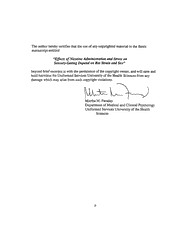
DTIC AD1011820: Effects of Nicotine Administration and Stress on Sensory-Gating Depend on Rat Strain and Sex PDF
Preview DTIC AD1011820: Effects of Nicotine Administration and Stress on Sensory-Gating Depend on Rat Strain and Sex
UNIFORMED SERV~C~S UNIVERSITY OF THE HEALTH SCIENCES 4301 JONES BRIDGEROAD BETHESDA. MARYLAND 20814-4799 APPROVALSHEET Title ofThesis: "Effects ofNicotine Administration and Stress on Sensory-Gating Depend on Rat Strain and Sex" Name ofCandidate: Martha M. Faraday MasterofScienceDegree 1998 Thesis and AbstractApproved: f~\J;~ ~< E phi»: 1erome E. Singer. Date 'tommittee Chairperson ~ ~~1. (7'7'7 Date @ Printed on Recycled Piper The authorhereby certifies that the use ofanycopyrighted material in the thesis manuscriptentitled: CiEffects ofNicotineAdministrationandStress on Sensory-GatingDependon RatStrain andSex" beyond briefexcerpts is with the permission ofthecopyrightowner, and will save and hold hannIess the Unifonned Services Universityofthe Health Sciences from any damage which may arise from such copyright violations. ~~Lt--J Martha M. Faraday DepartmentofMedical and Clinical Psychology Unifonned Services University ofthe Health Sciences u ABSTRACT TitleofThesis: Effects ofNicotine Administration and Stress on Sensory-Gating Dependon RatStrain and Sex MarthaM. Faraday,MasterofScience, 1998 Thesis directed by: Neil E. Grunberg, Ph.D. Professor DepartmentoflvIedical and Clinical Psychology The presentexperiments investigated effects ofnicotine administration, nicotine cessation, and stress (environmental and physical) on the acoustic startle reflex (ASR) and pre-pulse inhibition (ppn ofthe ASR (measures ofsensory-gating) in males and females oftwo rat strains. Experiment 1examinedeffects ofnicotine on 192 Long-Evans rats (a non-albino strain) in individual orcrowded housing. For males, nicotine increased startle and PPI in the crowded condition but decreased these responses in the individually-housed condition. Forfemales, nicotine reduced ASR and PPI regardless of housingcondition. Experiment 2 examined effects ofnicotine (0, 6, or 12 mg/kglday) and immobilization (llv1) stress on ASR and PPI ofmale and female Long-Evans and = Sprague-Dawley (albino) rats (N 240). Nicotine decreased ASR and PPI responses of Long-Evans subjects. Nicotineenhanced Sprague-Dawleysubjects' responses. Stress increased responses ofSprague-Dawleymales and Long-Evans females butdecreased responses ofSprague-Dawleyfemales and Long-Evans males. iii Effects ofNicotine Administration and Stress On Sensory-Gating DependonRatStrain andSex by MarthaM. Faraday Master's Thesis submitted to the Faculty ofthe DepartmentofMedical and Clinical Psychology Graduate Program ofthe Uniformed Services University ofthe Health Sciences in partial fulfillment ofthe requirements for the degree of MasterofScience 1998 iv ACKNOWLEDGEMENTS Onecannot handle over400 rats without a greatdeal ofhelp. I am indebted: to GinaMinich and Karin Hygge, whose reliable hands contributed greatlyto the smooth running ofExperiment2; to Matthew Rahman, fearless technocrat, from whom I learned that mastery oftemperamental equipment often is a matterofsheer persistence; to Peter Scheufele, whose insightful support took theform that was most needed atthe moment and ranged from logistics consultation to makingsure Iate lunch on busydays; and. to Neil Grunberg. my mentor, by whose patience, endurance, and care we all are provided with the opponunity to become betterscientists- and betterpeople - than we otherwise would have been. v TABLE OF CONTENTS Approval Sheet i CopyrightStatement ii Abstract .iii TitlePage .iv Acknowledgments v Table ofContents vi ListofTables xi ListofFigures xii Introduction I MajorEffects ofNicotine that Contribute to Self-Administration 2 Cigarette Smoking and Stress 3 Smoking and Individual Differences .4 Genotype and Smoking 5 Relevance to Clinical Use ofNicotine 8 The Present Research: Attentional Effects ofNicotine and Stress 9 1)Effects ofNicotilze 10 2) The AcousticStartle ReflexandPre-Pulse Inhibition: Behavioral Indices ofAttention 13 3)ASR-PPI, Drug Effects, andIndividual Differences 15 Human Studies 15 Rat Studies 16 vi 4) Stress alzdDrug Effects 22 5) ASR-PPI, Stress, andNicotine 24 6)ASR-PPI, Genotype, andGender 25 Summaryand General Purposes ofStudies 26 Specific Purposes ofExperiments I and 2 28 Experiment 1 29 Overvie\v 29 Hypotheses 29 Methods 33 Subjects andBaseline Phase Housing 33 Equiplnel11 33 Drug Adl1zinistratiol1andSurgical Procedure 35 EnvironmentalManipulation 36 Procedllre 37 Baseline Phase 38 Drug Administration Phase 38 Cessation Phase 39 Results 40 Data AnalyticStrategy 40 BodyWeight 40 ASR-PPI 40 Reslllts: Bod)' Weight 43 vii Results: ASR-PPIin DuringDrug Phase 44 Startle Amplitudeto 112dB 44 Startle Amplitudeto 122dB .45 AmountofPre-Pulse Inhibition to 112dB wI Pre-Pulse .45 Amount ofPre-Pulse Inhibition to 122dB wIPre-Pulse 46 Percent Pre-Pulse Inhibition to 112dB wI Pre-Pulse .46 Percent Pre-PulseInhibition to 122dB wIPre-Pulse 47 Results: ASR-PPIin Cessation Phase 47 Startle Amplitude to 112dB 47 Startle Amplitude to 122dB .47 Amount ofPre-PulseInhibition to 112dB wI Pre-Pulse .48 Amount ofPre-PulseInhibition to 122dB wI Pre-Pulse .48 Percent Pre-Pulse Inhibition to I12dB wIPre-Pulse .48 Percent Pre-Pulse Inhibition to 122dB wI Pre-Pulse .48 Confirmation ofHypotheses 49 Discussion ofExperiment I 52 Experiment2 55 Overview 55 Hypotheses 55 Methods 58 SubjectsandHousing 58 Equipnze1zt 58 viii DrugAdministration andSurgical Procedure 59 StressManipulatiolZ 59 Procedure 60 Baseline Phase 60 During Drug Administration Phase 60 Results 62 DataAnalytic Strategy 62 BodyWeight 62 ASR-PPI 62 Results: Body Weiglzt 65 Results:AcousticStartle andPre-Pulse Inhibition 67 Stanle Amplitude to 98dB 67 Stanle Amplitude to 112dB 69 StanIe Amplitude to 122dB 71 Amount Pre-Pulse Inhibition to 98dB wIPre-Pulse 73 Amount ofPre-Pulse Inhibition to 112dB wI Pre-Pulse 74 Amount ofPre-Pulse Inhibition to 122dB wI Pre-Pulse 76 Percent Pre-PulseInhibition to 98dB wI Pre-Pulse 79 PercentPre-PulseInhibition to 112dB wIPre-Pulse 79 Percent Pre-PulseInhibition to 122dB wI Pre-Pulse 81 Confinuation ofHypotheses 83 Discussion ofExperiment2 85 ix General Discussion 87 Experiment I 90 Strain Differences 91 SexDifferences 91 Experiment 2 92 Strain Differences 93 SexDifferelzces 95 Stress 96 Possible Mechanisms and Future Directions 97 Tables 103 Figures 108 References 130 x
